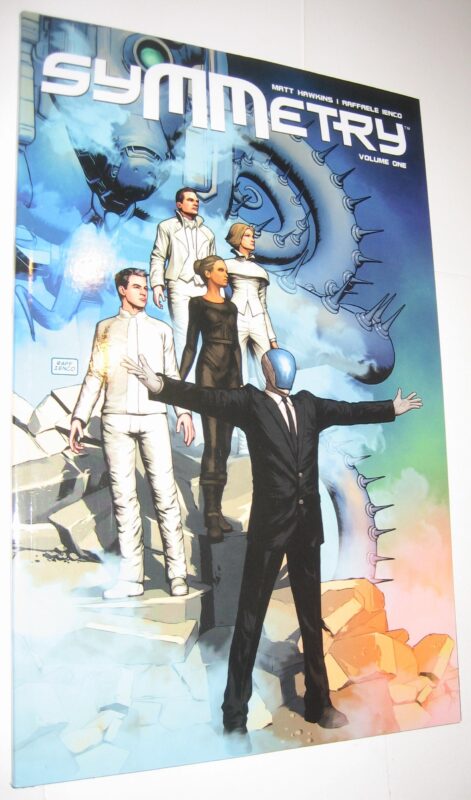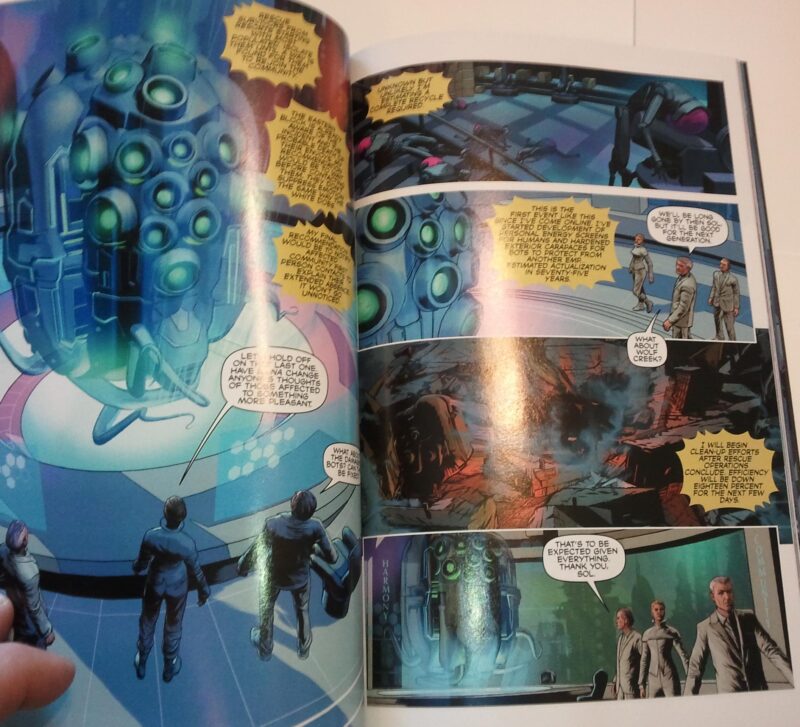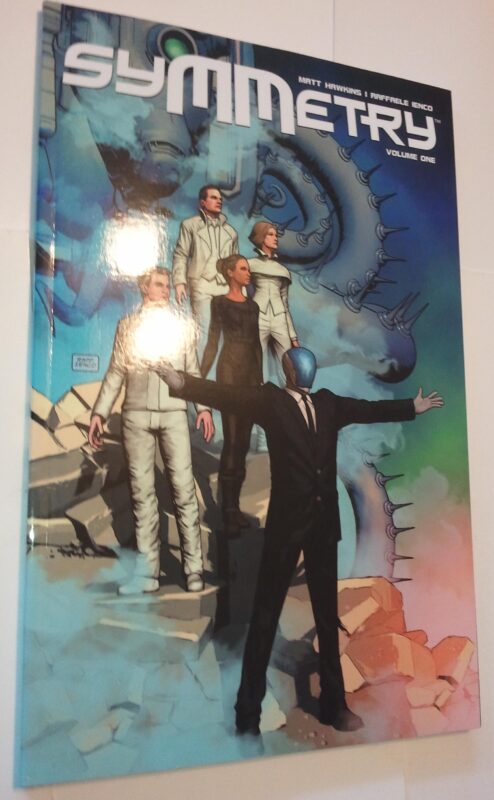Symmetry Volume 1 TP NM Matt Hawkins Raffaele Ienco Image Comics 1st print
$29.99
Description
SYMMETRY VOL 1 SC
PUBLISHER Image Top Cow
WRITER Matt Hawkins
ARTIST Raffaele Ienco
128 pages, FC Graphic Novel
Utopia is here. Hunger, sickness, work… all relics of a long forgotten past. All individuality, creativity, and negative emotions have been genetically bred out and medically suppressed. The population is limited to segregated areas, but when a natural disaster disrupts the status quo and Michael and Maricela from two different worlds meet and fall in love, their relationship sparks a revolution. Will their love cause the salvation or destruction of mankind?
Collects Symmetry #1-4.
What you have in SYMMETRY is a carefully crafted arc involving a utopian society that quickly goes dystopian after a cataclysmic event. Humanity has developed a “perfect” society based on robot guides and chemical suppression of emotions, but when all that shuts down, human nature is allowed to surface, and it’s time for the elite overlords to take drastic action.
It’s a good read, and the back matter shows the depths of study that Matt Hawkins has put into the book — he even provides interesting links to show from where he derived some of his ideas and material.
Symmetry will go down as one the the strongest utopian graphic novels of its time.
This series is a extravagant blend of Aldous Huxley’s Brave New World but with the look and feel of H.G. Wells’ War of the Worlds.
Matt Hawkins and Raffaele Ienco are a power duo that make telling action packed sci-fi comics look easy. The art in Symmetry gets better in every issue. It’s a crying shame that Ienco doesn’t get recognized in comics for a best colorist award. Each page is perfectly calculated from the panel structure, colors, and masterful storytelling. Troy Peteris does a brilliant job at lettering by making it easy to read and know when to get out of Ienco’s way.
Telling a complex story isn’t enough for Hawkins. His fluid dialogue and cliffhangers make Symmetry a fun read while making the reader question the world around them.
Hawkins tastefully takes the popular dystopian, sci-fi tech genre and puts it on its head by introducing the idea that minorites will be in the future too (a concept Hollywood still can’t understand). It’s hard to find a comic (and in film and television) that deals with racial inequality without a cliche and stereotypical characters or plotlines.
This is a must read for fans of Brave New World and Equilibrium.
Matt Hawkins is a familiar name in the annals of independent comic book history. Having been with Image Comics almost since its initial launch in 1992, Hawkins famously asked for a job from Rob Liefeld while in line at an Extreme Studios event in the summer of 1993. Now president and COO of Top Cow comics, he has also written several books that explore the relationship between humanity and technology. Books like Think Tank, the story of a brilliant young inventor who became trapped in the military industrial complex at a young age, continue to touch both of those worlds closely. Paralleling themes of man and technology are books like Golgotha, the video game adaptation Warframe, Symmetry, and others, as well as the superheroes-meets-transhumanism universe of Aphrodite IX and Cyberforce.
Hawkins’ journey into comic books started as improbably as one would expect, considering where he comes from.
“I have a master’s in physics that I never used for anything. My dad was an engineer for the military in the 70’s and 80’s, part of the Cold War, and he’s long retired.”
Being involved in the early days of Image Comics seemed to hook Hawkins into the world of comics, even if that didn’t always thrill the family back home.
“My sister’s an astrophysicist. I’m the black sheep of the family that I do comic books.”
While with Top Cow, he went on to write Lady Pendragon, and helped with The Darkness video game. He also worked with with guys like Mike Turner, David Finch, Joe Benitez, J Michael Straczynski, and Mark Millar during his time at Top Cow.
Matt’s work asks questions like, What does the future tell us about who we are in our present times, in which we constantly deny science in the name of politics?
To that, he responds, “I think it says we’re a bunch of morons. I really do, because I run into these people that are the anti-vaxxers, and some of these people, like the flat earth people. . . these people are real. I’m still shocked.”
This rejection of what was once accepted as scientific fact is what built the foundation of one of Hawkins’ more notable works: “I’m kind of fascinated by future dystopian utopian. I tried to create a utopian book with Symmetry and I realized it’s just not possible.”
Symmetry, which touches on the idea of a perfect society, plays up some of the natural tendencies of humanity. In Symmetry, humans have artificial intelligences implanted into our heads as a fetus, and we choose our names and genders at the age of 13. From there, our whole idea of humanity and culture is shaped by a fictionalized and seemingly distorted view of history.
“The whole idea is you create a utopian society and watch it crack and crumble–definitely some influence from Brave New World (love that book), and a little 1984.”
After an accident separates man from artificial intelligence, Hawkins’ characters are left to their own devices and must figure out the world for themselves. Once the AI is able to return, what does the world look like and what has it become? These are the things that people often ponder about technology, sometimes not realizing our level of reliance on it. “I’m fascinated by religion, fascinated by science and philosophy and how these interact and affect us. I’m always amazed when people tell me, ‘Oh, if I went back 300 years from the future, I’d be a God.’ No, you don’t know how to do anything.”
It’s this reliance on technology that has become the new religion in Hawkins’ fictional worlds.
“There’s a running theme in my work. I was raised as an evangelical; my parents are still evangelicals, right-wing conservative Christians, and I abandoned that faith entirely at the age of 27. I became one of those douchey atheists for a couple years that are, like, militant, ‘You’re a moron for believing this,’ and then I finally got through that. I tell people who become atheists, ‘Don’t do that. It’s just wrong.’”
This intertwining of religion and technology pushes the boundaries of humanity and the future. How far can we go as a people? What will that world look like? “I always tell people to keep an open mind… keep an open mind about everything.”
This open mind, though, can cut both ways, as humanity as a whole has long struggled to make the best choices for what it should do with its technology. The future is as scary as it is wide open, something that has long been in the back of Matt Hawkins’ mind: “I hope we don’t kill ourselves.” A pessimistic view or an honest one? That is something only time can tell.
Utopia always has a price.
Even a technologically advanced one where all it takes is just a simple solar flare to change the world.
That’s the setup of Symmetry, the latest series created by Matt Hawkins and published by Image Comics.With art by Raffaele Ienco, Symmetry is set in a future where everything seems…perfect.
The series caught our attention thanks to its solid science footing – a common theme with comics written by Hawkins, and kept us for the deeper questions it starts to ask when everything starts to go to hell.
The son of an engineering officer in the Air Force, Hawkins studied Physics and Applied Science at UCLA after a few years at UC Riverside. Hawkins lived the typical military life while growing up – moving every few years – but as schools changed with regularity, Hawkins found something that stayed constant – his love of science and math. Exactly what you’d think a comic book writer and comic book studio President and COO would be well-versed in, right?
“My sister has multiple post-grad degrees in different science fields and she went to work for the California Highway Patrol,” Hawkins said. “Go figure, we’re weird. We’re all fairly overeducated for what we ended up doing. I’ve always had a personal passion with trying to figure out the ‘why’ of things. I had a chemistry set when I was very young and my parents both encouraged me.”
Hawkins was in the mix of the original Image Comics launch back in the early ‘90s before moving to Top Cow where he’s served as President/COO since 1998. Hawkins’ keen eye for the deal and knowledge of the comic book business has kept him in the game as an executive for more than 20 years, while his imagination and storytelling skills have set him apart as a creator. While Hawkins’ early works were somewhat diffuse in regards of genre, moving from fantasy to crime-action and futuristic science fiction, his creative pendulum was been tracing out a more narrow path lately.
While he still works with some franchise properties, Hawkins’ own and co-created properties have taken on a more mature and inquisitive tone as he’s gotten older. His Think Tank pushes at the science boundaries of the world while wondering what one man should do to change the world if he can; The Tithe pokes at organized religion, Postal drinks deep of the darkest recesses of human nature, and Symmetry takes readers into a perfect future…that apparently was only hanging by a thread.
We’re here to talk Symmetry, or more specifically, the science behind the story, which deals with a utopia, a very powerful A.I. named SOL, and the engineering, both technological and social, that’s needed to make such a world work.
The Science Of: To start with Matt, and you mentioned it a little in the back of issue #1 – when you settle in to write a story such as Symmetry, there’s a lot of research that goes into it. For this book – what roads did the story take you down?
Matt Hawkins: Studying utopian systems and communist ideology was new for me. Being raised a right-wing conservative Christian it was initially hard for me to not reject it. My more liberal adult self was more embracing once I got past the initial revulsion. It was interesting to read Marx, Engels and study the various attempts at creating even “city utopias” as some have tried. How and why do you build a utopia?
TSO: When it comes to researching something like this, what’s your roadmap? This series isn’t your first go at this kind of story with some in-depth science, so do you have a tried and true plan?
MH: When I have an early idea, I start Googling various things about it. I can usually identify quickly a couple books on the subject that people refer to. I then read those and delve deeper based on the new knowledge. At this point, and this is my favorite part, I’ll reach out to The Science and Entertainment Exchange who connects writers with specialists in various science fields. I’ve met a lot of people that way. One intro they made led me to about ten other scientists I’ve had the pleasure of buying a beer. I also reach out on social media. With the exception of a few known science celebrities (Michio Kaku, Bill Nye, Neil Tyson) the rest are relatively obscure. Even the more published ones may only have a few hundred Twitter followers. My favorite question to answer scientists is what scares them. Their answers are generally stuff I haven’t even heard of. For Symmetry I met with a sociologist who gave me a lot of ideas but asked to remain anonymous.
TSO: What’s your signal that you’ve done enough research and are ready to write?
MH: The research never really stops, but when I feel I’m well-versed in the subject matter I’ll sit down and write an outline. At that point, despite my desire to educate it becomes an exercise in writing character-based fiction that people will hopefully enjoy.
TSO: Digging in to the world of Symmetry, central to the world was the creation of A.I., and it becoming ubiquitous in the lives of the people of earth. The idea of A.I.’s has taken some hits recently from Hawking and Musk, but yours is benevolent. Tell me about your view on A.I. will it be good or bad for humanity?
MH: This is the question! Humans are irrational. We make bad decisions all the time for emotional reasons. We’ve reshaped the entire earth to suit our purposes and have wiped out other species on the planet merely for being in our way. So if robots think rationally and not emotionally, is that good or bad? Ultimately, this depends on who’s in charge. If humans control robots or have some form of “off switch” then we’re never in any real danger. In most fictional sci-fi stories where the robots attack us, they become self-aware and decide humans are bad and then try to set us straight. This makes for a good fictional story, but if we’re working hand-in-hand with robots and AI and they are engineered specifically to work with us and have our best interests at heart…would this happen? I really don’t know. I respect Hawking, but at this point he’s just trying to sell books…as am I.
TSO: SOL’s somewhat unique in terms of A.I.s that we’ve seen recently in science fiction – benevolent, a gentle guiding hand to humanity where humans seem to be the true villains in their own utopia. I have to say, both in science fiction and in current commentary, that’s a minority view of superintelligent A.I. Do you really think we could engineer an A.I. like SOL?
MH: It’s the more logical outcome of our efforts. That doesn’t make it a reality, but part of my interest in this story was to challenge that basic preconception of A.I. At this point, we have no basis for believing it other than fiction. So why are we assuming it? And how about channeling more effort into developing it so it doesn’t happen? The problem with humans is that we compete with each other and do not have each other’s best interests in our mind. We’re selfish and egotistical. Robots are none of these things. We like to graft our own imperfections on other things. We anthropomorphize animals all the time in a similar way.
TSO: We tend to both idolize and fear an A.I. Most models of a curious A.I. predict it would have alien, god-like intelligence within a handful of iterations. You seem to be saying, in Symmetry, that perhaps even a created god like SOL can’t create a utopia…
MH: We make irrational decisions based on emotion. We are willing to kill each other over resources, even when there are alternatives available. We do stupid, self-destructive things and a lot of people have no real plan for anything. In my story, which I feel is closer to reality, humans are always the cause of drama and problems.
TSO: Let’s get into the world-buidling a little. What are some of the things that had to happen in order to lead the world into the “symmetry” it enjoyed prior to the events we see? That is – what’s a timeline look like, technology-wise that gets us from today to Symmetry?
MH: The backstory of how and why SOL (the main A.I. which stands for System Optimizer for Longevity) came online is the thrust of the second arc of the book so I don’t want to get into it too much. How far off is this in the future from today? I have no idea. Some people say we’re looking at universal A.I and robots doing the bulk of labor in the next 50 years. I doubt that, but it’s certainly viable in the next couple centuries. This story takes place thousands of years in the future.
TSO: Knowing that you keep your finger on the pulse of cutting-edge science for this and Think Tank, you’ve certainly seen the recent stories about DARPA looking to network brains – something that you suggested with your similar creation in Symmetry, RAINA. How far away do you think we are from something like a rudimentary RAINA?
MH: We are already living in an era of the “internet of things” where refrigerators and garage door openers are networked already. Cybernetic enhancements exist with people wearing pacemakers, eye-implants and an increasing array of bio-implanted technologies and peripherals are on the horizon. I dealt with this in my other title Think Tank where you could wirelessly hack someone’s pacemaker and turn it off. We’re looking at brain chips in the next 20-50 years that will replace computers and people will access the internet and communicate that way. Somewhere down the line a brain cap would be introduced, perhaps in utero that would grow with the brain and interface more fluidly with technology. The RAINA (responsive artificial intelligence network archetype) is a liquid inserted into the brain in utero and becomes part of your brain. This is several steps down the line, but entirely feasible…eventually.
TSO: For Symmetry, you move out of say, the hard sciences of Think Tank, and into social sciences with the idea of a utopia. Is the idea of a utopia something that is still being discussed and researched, at least in thought experiments? It seems like it’s always a myth, and deep down we know it’s a myth, yet we all, at times, seem to crave it…
MH: The idea of an egalitarian society is appealing. Especially today with the insane disparity of economic classes. People act like it’s new, but the ultra-rich are just the new nobility. We award wealth in silly ways. We pay entertainers way too much and scientists way too little. The problem with utopia is it flies in the face of what we see as our natural instincts. I’m conflicted. I see the value of a meritocracy or a geniocracy over a democracy or republic. Communism has a bad name and it’s too linked to utopian thought currently to make it truly viable. That may change over time.
TSO: Not to spoil any part of the storyline, but it seems that, for such a utopia to exist as one does in Symmetry, difficult decisions were made that would not, or were not supported by the entire population, resulting in…steps needing to be taken. There is always a cost to utopia, isn’t there?
MH: It’s the age old, do “the needs of the many outweigh the needs of the few” question. Rationally, the answer is yes, but tell that to any minority group. It sucks to be one of the few. It’s clear a lot of steps were taken out of desperation to get this society where it is today. They needed medication to suppress certain emotions. They needed stuff for people to do now that they no longer had jobs. This is what the second volume is about as well. What is your purpose? Is achievement important? In the story there are several updates that are made over time by the system. These are all to enhance the human experience and life.
TSO: In the bigger picture, and going back to the idea of science vs. story, what’s your comfort level with “bending” science a little to serve the purpose of the story? Does everything in your science fiction stories have to be explainable by the science in the world you’re showing, or do the needs of the story sometimes outweigh the needs of the science?
MH: The story always comes first. I fudge a lot and I think with far off sci-fi stuff that’s okay as long as it’s plausible. We really can’t predict what the future will be like. Something could change everything next year and everything we thought we ever knew would be different. What if we found out without a shadow of a doubt that humans originated on another world and were seeded here. Would change a lot. In a book like Think Tank where the lead character is a scientist, I spend a lot more time to make it authentic. I call that a “science thriller”, it’s still fiction of course but it’s all based on real world stuff. This is easier to do because it takes place in the present.
TSO: Finally, Matt – you mentioned in the back of issue #2 that you’re a creative person at heart, not a rebel. You’ve made a niche for yourself in telling science fiction stories – what do you see as the role of the creator or the storyteller in science, and using science to tell stories?
MH: I think this is so important! Kids needs to read science fiction to get inspired to join the sciences. I read a lot of Asimov and Clarke as a kid and if I never had my life would have been very different. Learning and imagination are complementary and I love educators who use this to teach. My favorite classes were always ones that captured my imagination and made me wonder. It’s important for us to see scientists as exciting, interesting and world changing. If you can entertain while clandestinely educating, that’s a win-win.
978-1632156990
Collects Symmetry 1-4. Near mint condition, 1st printing.
Related products
-
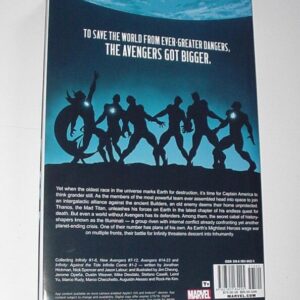

Infinity HC Omnibus Thor vs Thanos Hulk Jonathan Hickman 1st print
$199.99 Add to cart -
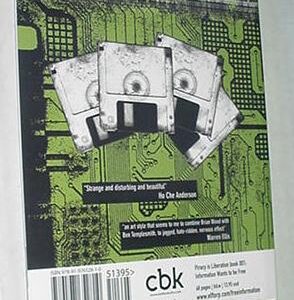
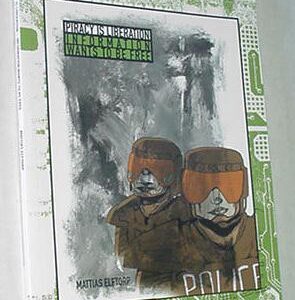
Piracy is Liberation Vol1 Info Wants to Be Free TP 1st print Mattias Elforp
$49.99 Add to cart -

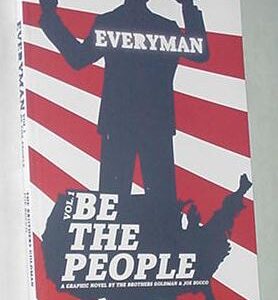
Everyman V1 Be the People TP Political Graphic Nov
$49.99 Add to cart -


Green Lantern by Geoff Johns Volume 1 Omnibus HC 1st print NM vs Batman! Ethan Van Sciver
$249.99 Add to cart
